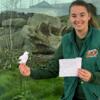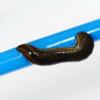Researchers found significant results regarding elephants, with social activity among the animals increasing, and repetitive behaviours - which often indicate boredom - decreasing during public feedings.
Animal behaviour experts at Nottingham Trent University and Harper Adams University looked at more than 100 previous research papers exploring the various ways in which visitors impacted behaviour across more than 250 species in zoos.
The findings indicate that elephants in particular reacted positively to visitors.
According to the researchers, the repetitive behaviours also decreased in the presence of larger numbers of visitors.
The study also found that in the period after public feedings there was increased foraging by elephants and a decrease in their levels of inactivity.
However, elephants are not the only animals that react positively to zoo visitors.
Other species which displayed a positive response to visitors included penguins, jaguars, grizzly bears, polar bears, cheetahs, servals, banteng and black-tailed prairie dogs.
The social behaviour of cockatoos was also seen to increase - possibly as a result of the visitors stimulating the birds.
While another bird, the long-billed corella, spent the majority of time on busy days closer to the visitors, it was found.
Dr Samantha Ward, a zoo animal welfare scientist at Nottingham Trent University's School of Animal, Rural and Environmental Sciences, said: "Some animal species have been born and raised in zoos and so have likely become used to the presence of humans.
"Zoo visitors are often aspects of a zoo animal's environment that animals cannot control and as such can be stressful, although some species appear to show good adaptability for the changing conditions of visitors.
"There can be a lot of variation in stimuli from visitors in terms of their behaviour, the noise they make and the way they interact with the animals.
"We have identified that species show varied responses to people in zoos - some cope well, others not so well."
According to the findings, across all studies the interpretation of the impact of visitors was predominantly neutral, with some considered positive and negative.
Animal groups for whom visitors were reported to have a negative impact included flightless birds, odd and even-toed ungulates, marsupials, ostriches, tuatara and hedgehogs.
Dr Ellen Williams, a zoo animal welfare scientist at Harper Adams University, said: "We have robust methods to measure animal welfare in zoos. Animal responses are attributed to various factors and recognising what these may be is important to improve welfare.
"In elephants and birds it was encouraging to see a reduction in those repetitive behaviours towards something more positive in the presence of people, although the absence of change in the majority of species was also really good, because it suggests enclosure design is changing to better support animals in responding to visitors."
The research is published in the journal Animals.
-
News
 Welsh Mountain Zoo champions “Conservation Christmas” - promotes eco-friendly festivities in North Wales 25th November, 2024The Welsh Mountain Zoo has launched an exciting new community project for schools, learning groups, and local organisations across North Wales. The ‘Conservation…
Welsh Mountain Zoo champions “Conservation Christmas” - promotes eco-friendly festivities in North Wales 25th November, 2024The Welsh Mountain Zoo has launched an exciting new community project for schools, learning groups, and local organisations across North Wales. The ‘Conservation… -
News
.png?w=100&h=100&zc=1&f=jpeg&hash=994df0a47a25bb4171ed3ebe3db59a16) Blog: Why I look at the trees when visiting zoos 25th November, 2024Healthy terrestrial ecosystems depend on healthy trees. Meet the conservationists doing crucial work monitoring and educating about tree diseases…
Blog: Why I look at the trees when visiting zoos 25th November, 2024Healthy terrestrial ecosystems depend on healthy trees. Meet the conservationists doing crucial work monitoring and educating about tree diseases… -
News
 Great suck-cess! Scottish breeding programme sees first baby leeches born 22nd November, 2024A project to help restore Scotland’s population of medicinal leeches has welcomed the arrival of the first babies. Over the past month,…
Great suck-cess! Scottish breeding programme sees first baby leeches born 22nd November, 2024A project to help restore Scotland’s population of medicinal leeches has welcomed the arrival of the first babies. Over the past month,…


